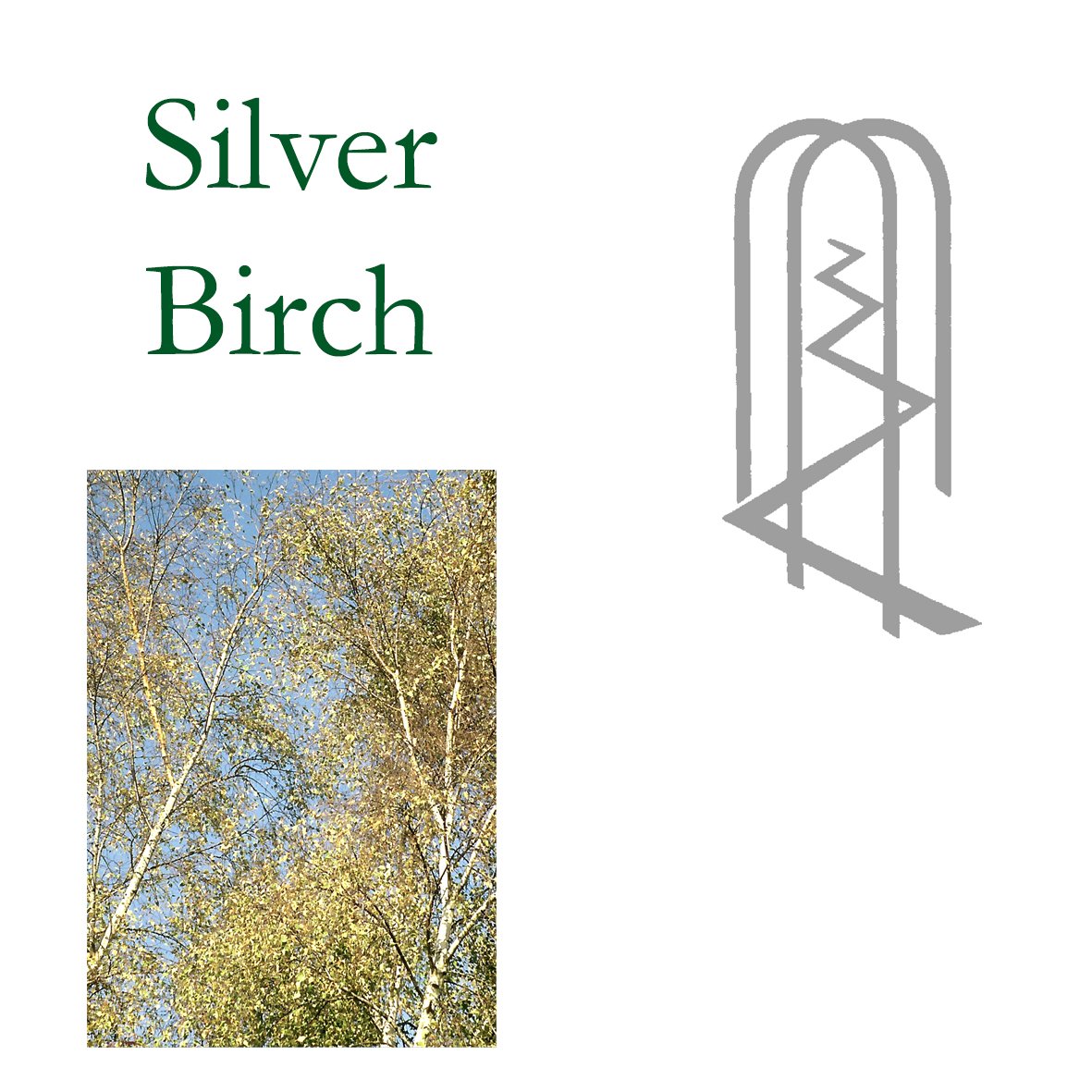SILVER BIRCH (Betula pendula, Betula pubescens)
Key: Beauty
The two native birches, the silver birch and the downy birch occupy different environmental niches and have distinct forms although cross-breeding occurs between them. Energetically they bring very similar energies as expressed through the focus of the land.
The droopy-branched silver birch has a tall, pointed crown with a delicate, weightless and supple appearance. Mature trees are characterised by the silver-white bark marked with black. The leaves have flat bases and alternate larger and smaller teeth. Silver birch favours dry, sandy soils. It can reach 100ft (15m) but is more often half this size. Birches are short lived, usually no longer than 100 years and have the characteristic hardiness and rapid growth of pioneer species.
Downy birch favours heavier, wetter soils so where silver birch occupies valley sides and heathland, downy birch can more often be found in valley bottoms, marshy ground and closer to water. The tree is sturdier, less tall (up to 80ft, 24m), and has fewer, thicker and less pendulous branches. The bark tends to be darker but can also be silver, and the leaves have more even teeth and a triangular base. As its name suggests the stalks are hairy whereas the silver birch is hairless.
The spirit of birch brings the ability to experience beauty and calmness. The name of the tree derives from the Indo-European root “bharg” which means bright, shining, white. The experience of beauty is more than a simple appreciation of form: it is an acknowledgement and realisation that everything that is, rejoices in its own nature, its own life – that simply being is sufficient to create endless joy within oneself. Beauty is the acknowledgement of this simple goodness of being, both in oneself and in others. Without the awareness of beauty there can be only separation and division.
Encouraging this quality birch helps to ease harsh judgements of the self and of others. It can give the ability to understand and accept other people’s views without criticism. Supporting individuality and nurturing life feed one’s surroundings and reflects back life-supporting energy into oneself.
Harmonious sharing is encouraged. This state then allows the further growth and manifestation of new beginnings and new possibilities for great happiness. Birch will be of use to those who find it difficult to express themselves.
The experience of quiet and deep beauty helps to release old patterns of behaviour. Beauty is the experience of the transcendent within the present, and as such this essence effectively dissolves the rigidity and stubbornness that prevents clarity and flexibility of action and perception.
Signature: Birch is a pioneer tree that provides a fertile environment for many other forms of life – to which it will eventually give way. The quality of flexibility and grace is apparent in the form. Another form of flexibility appears in the slight modification of characteristics between the two species in different habitats.
Comment: Birch has always been connected to concepts of brightness – in terms of fire (birchwood burns very brightly), and in terms of colouration, habitat and spiritual energy. Birchwoods are very light places and many other species can grow up underneath protected by the birch trees and fed by their rotted leaf litter. The white bark stands out clearly like a torch or way marker. The slender grace of many birches seems feminine to many and they have been long connected with both nurturing Mother goddesses (many of whose names also spring from the same roots and signify fire, brightness, whiteness such as Brigid, Bride, Beorc, Birkana), and with goddesses of death – white also having obvious correlations with dead flesh, bone, winter and cold.
Understanding the harmony between these concepts is the key to experiencing beauty as a permanent reality of perception, rather than as a fleeting glimpse of something beyond greatness. The birch spirit confronts each person with unglamourised reality, with things just as they are: with death as well as life. It can begin to move us towards a position where beauty spontaneously shines through everything, instead of our continual defining of things as good or bad. Birch is a tree of tantric teachings. It allows us to work with everything in front of us in our lives, both what we love and fear, in order to taste the real taste of experience which is essentially as sweet as the sap of the birch, and as sustaining.
The relationship of birch with the fly agaric mushroom (Amanita muscaria), which is its favoured host, is also one that repays deeper investigation. This fungus has an undisputed history of magical and shamanic use. It, too, has a form that allows associations of both male and female gender, a reputation of death, danger and exaltation and a connection to light. This unpredictable mushroom spirit can bring to its human communicant discomfort and oblivion (though not death of the body) or an increasing bliss that climaxes in the experience of a celestial light flooding down onto the head. This light, together with the red and white-flecked cap, blood and bone, life and death, menstrual blood and semen, its appearance after fertilising rains in autumn, all reinforce and strengthen the constellation of associations that birch itself conjures up.

